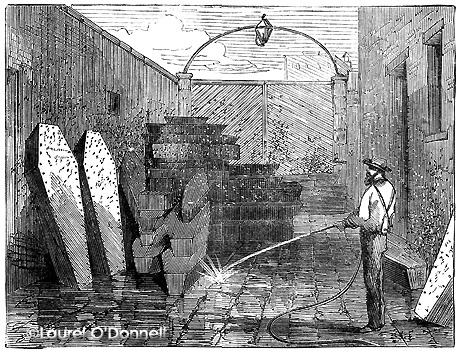|
|
Chapter V
Institutions of Manhattan Island and Westchester Co.
Bellevue Hospital
(Twenty-Sixth Street, East River.)
THE Bellevue Hospital is one of the largest Institutions of its kind in the United States, and one of the noblest monuments of municipal charity in the whole world. In 1816 a stone building fifty feet by one hundred and fifty was erected at Bellevue, as a penitentiary for minor offenders. The same year the new alms-house was erected in close proximity to the latter, and in 1826 the Hospital was established near the two just described. The three Institutions, and over twenty acres of land', were enclosed with a stone wall, and became known as the Bellevue establishment. The opening of the House of Refuge in 1825, and the prison at Sing-Sing in 1828, furnished accommodations for criminals, so that at the removal of the inmates of the almshouse to Blackwell's Island, in 1848, the Hospital interest naturally took the entire possession of Bellevue.The old almshouse, constructed of blue-stone, is now the central edifice of the Hospital. Various changes and additions have been made from time to time, until the buildings now present a continuous line of three hundred and fifty feet, all four stories high, the central one crowned with a lofty observatory. The Hospital contains thirty-five wards, and has space for about twelve hundred patients. The ceilings are now considered too low and the ventilation quite defective, yet every improvement possible for the comfort of the patients is made. The Hospital is heated throughout with steam, the cooking and washing being performed by the same agent, and the apartments are all lighted with gas. Each building has a piazza with external iron staircases, affording pleasant exercise to convalescents, and ample means of escape in case of fire.  Bodies at the Morgue Awaiting Identification and Removal. In the basement of the main building are kept the drugs, the Hospital clothing, and much of the provision stores. Here is also the printing office of the commissioners. The side walls of the wide entrance way of the first floor present on the one hand the stone on which George Washington stood when he took the oath of office as first President of the United States. The stone is appropriately inscribed. On the opposite side the commissioners have placed a beautiful inscription in white marble, to the memory of Dr. Valentine Mott, so long regarded as the chief ornament of the medical fraternity of New York. The office of the warden and the business room of the commissioners are found on the first floor, and on the second are private apartments for the warden, engineer, apothecary, and matron. The third floor contains similar apartments for the resident physicians and surgeons; while the fourth contains the operating theater, surrounded with circular seats raised in the form of an amphitheater, with space for several hundred students. This floor contains also the library, and the consultation room. |
|
196
:: Previous Page :: Next Page ::
:: Table of Contents :: :: New York State :: :: History Readings :: Books & articles appearing here are modified adaptations
from a private collection of vintage books & magazines. Reproduction of these pages is prohibited without written permission. © Laurel O’Donnell, 1996-2006.
|
|

